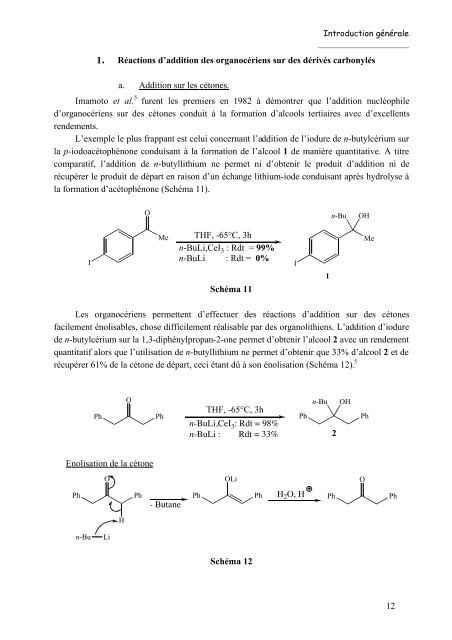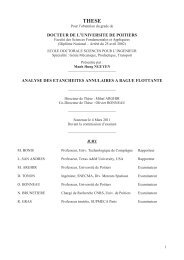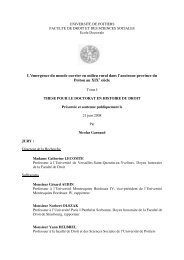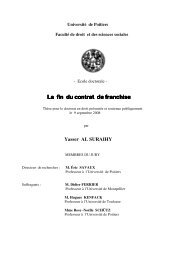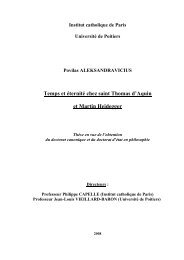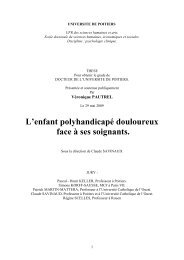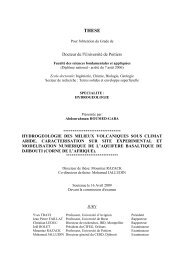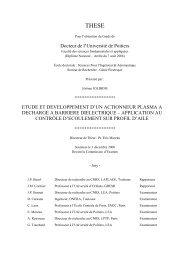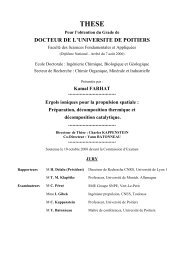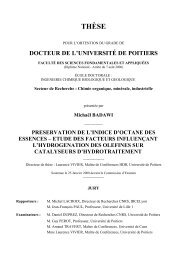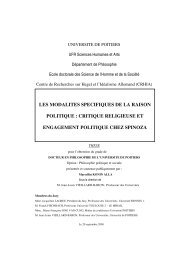- Page 1: Thèse Pour l’obtention du Grade
- Page 4 and 5: « J’ai vu plus loin que les autr
- Page 6 and 7: Je voudrais dire un grand merci à
- Page 8 and 9: SOMMAIRE INTRODUCTION GENERALE 5 I.
- Page 10 and 11: Introduction générale 2. Réactio
- Page 12 and 13: Introduction générale Introductio
- Page 14 and 15: II. Préparation des organocériens
- Page 16 and 17: a CH3CO2Et Cl2CeCH2CO2Et a O OCeCl2
- Page 20 and 21: Introduction générale Imamoto et
- Page 22 and 23: i-Pr N Ph O Ph O O CO 2Et O OH NMe(
- Page 24 and 25: Introduction générale Par la suit
- Page 26 and 27: Introduction générale l’espèce
- Page 28 and 29: Ph OM O -78°C, THF M = Li : Rdt =
- Page 30 and 31: Introduction générale agent antib
- Page 32 and 33: Ce manuscrit se composera de trois
- Page 34 and 35: Chapitre I : Synthèse d’arylcycl
- Page 36 and 37: ArBr + Ar = (4-COMe)Ph Tableau I-1
- Page 38 and 39: Ar N 2 X = N X O 2 S S O 2 + Pd(OAc
- Page 40 and 41: présence de Nickel (Schéma I-8).
- Page 42 and 43: éducteur pour régénérer les esp
- Page 44 and 45: Chapitre I : Synthèse d’arylcycl
- Page 46 and 47: H Chapitre I : Synthèse d’arylcy
- Page 48 and 49: 1. Mise au point des conditions op
- Page 50 and 51: O R B Cl S O H Ar = (4-OMe)Ph R = H
- Page 52 and 53: Chapitre I : Synthèse d’arylcycl
- Page 54 and 55: Chapitre I : Synthèse d’arylcycl
- Page 56 and 57: Chapitre I : Synthèse d’arylcycl
- Page 58 and 59: 48 à partir de l’acide isobutyri
- Page 60 and 61: Chapitre I : Synthèse d’arylcycl
- Page 62 and 63: O H Me p-MeC 6 H 4 SO 3 H toluène
- Page 64 and 65: l’étape suivante sans purificati
- Page 66 and 67: éactionnel) (Schéma I-37). OTMS M
- Page 68 and 69:
IV. Conclusion du chaptire I Chapit
- Page 70 and 71:
Chapitre II : Synthèse de benzazé
- Page 72 and 73:
O CO 2H O ( ) n 82-84 n = 1, 2 et 3
- Page 74 and 75:
Chapitre II : Synthèse de benzazé
- Page 76 and 77:
Ylures de carbonyle Imines de carbo
- Page 78 and 79:
Chapitre II : Synthèse de benzazé
- Page 80 and 81:
N Me CHO Chapitre II : Synthèse de
- Page 82 and 83:
MeO MeO MeO MeO H Chapitre II : Syn
- Page 84 and 85:
Chapitre II : Synthèse de benzazé
- Page 86 and 87:
Chapitre II : Synthèse de benzazé
- Page 88 and 89:
Entrée n 1 2 3 4 5 6 7 8 1 2 3 98-
- Page 90 and 91:
Chapitre II : Synthèse de benzazé
- Page 92 and 93:
Chapitre II : Synthèse de benzazé
- Page 94 and 95:
Chapitre II : Synthèse de benzazé
- Page 96 and 97:
Chapitre II : Synthèse de benzazé
- Page 98 and 99:
Chapitre II : Synthèse de benzazé
- Page 100 and 101:
Chapitre II : Synthèse de benzazé
- Page 102 and 103:
II. Conclusion du chapitre II Chapi
- Page 104 and 105:
I. Introduction 1. Historique Chapi
- Page 106 and 107:
Chapitre III : Essais vers la synth
- Page 108 and 109:
MeO HO O Br Chapitre III : Essais v
- Page 110 and 111:
Chapitre III : Essais vers la synth
- Page 112 and 113:
Chapitre III : Essais vers la synth
- Page 114 and 115:
MeO GPO 2. Schéma rétrosynthétiq
- Page 116 and 117:
Chapitre III : Essais vers la synth
- Page 118 and 119:
3 Bn 4 Me Chapitre III : Essais ver
- Page 120 and 121:
MeO MeO Chapitre III : Essais vers
- Page 122 and 123:
Chapitre III : Essais vers la synth
- Page 124 and 125:
MeO MeO 9-BBN = Br 190 H B 9-BBN (1
- Page 126 and 127:
Chapitre III : Essais vers la synth
- Page 128 and 129:
Chapitre III : Essais vers la synth
- Page 130 and 131:
Chapitre III : Essais vers la synth
- Page 132 and 133:
S R 1 S H S R-Li R 1 Me 2N O Chapit
- Page 134 and 135:
162 164 181 172, 174 R = H, Me OH O
- Page 136 and 137:
OTBS 197 198 199 NH S S CHO S MeO M
- Page 138 and 139:
Conclusion générale Conclusion g
- Page 140 and 141:
Partie expérimentale Partie expér
- Page 142 and 143:
Partie expérimentale Les chromatog
- Page 144 and 145:
Synthèse d’arylcycloalcènes Par
- Page 146 and 147:
4-(cyclohexé-1-ène)-anisol 31 MeO
- Page 148 and 149:
4-(cyclopent-1-ène)-anisol 34 MeO
- Page 150 and 151:
4-(6-méthylcyclohex-1-ène)-anisol
- Page 152 and 153:
8-anisol-1,4-dioxaspiro[5.4]dec-7-
- Page 154 and 155:
1-(cyclohexa-1,3-diènyl)-2-méthox
- Page 156 and 157:
Partie expérimentale du Chapitre I
- Page 158 and 159:
(±)-Laurokamurène B (1-méthyl-4-
- Page 160 and 161:
Partie expérimentale du Chapitre I
- Page 162 and 163:
(2,3-diméthylcyclopenten-1-énylox
- Page 164 and 165:
Synthèse des aldéhydes 77-79 2-cy
- Page 166 and 167:
Rf = 0,61 (Pentane/Et2O : 90/10); v
- Page 168 and 169:
Partie expérimentale du Chapitre I
- Page 170 and 171:
Synthèse des alcools 93-95. Partie
- Page 172 and 173:
1-(2-(1,3-dioxan-2-yl)phényl)cyclo
- Page 174 and 175:
2-(2-bromophényl)-1,3-dioxane 96 c
- Page 176 and 177:
2-(2-cyclohex-1-ènyl)-1,3-dioxane
- Page 178 and 179:
2,3,4,9-tetrahydro-1H-fluoren-9-ol
- Page 180 and 181:
Partie expérimentale du Chapitre I
- Page 182 and 183:
Partie expérimentale du Chapitre I
- Page 184 and 185:
Partie expérimentale du Chapitre I
- Page 186 and 187:
IR (KBr) ' (cm -1 ): 2931; 2838; 17
- Page 188 and 189:
Partie expérimentale du Chapitre I
- Page 190 and 191:
Partie expérimentale du Chapitre I
- Page 192 and 193:
2-méthyl-2,3,7,8,9,9a-hexahydro-1H
- Page 194 and 195:
Partie expérimentale du Chapitre I
- Page 196 and 197:
2-bromo-3-hydroxy-4-méthoxybenzald
- Page 198 and 199:
Partie expérimentale du Chapitre I
- Page 200 and 201:
Partie expérimentale du Chapitre I
- Page 202 and 203:
CH(c)). Partie expérimentale du Ch
- Page 204 and 205:
Partie expérimentale du Chapitre I
- Page 206 and 207:
Partie expérimentale du Chapitre I
- Page 208 and 209:
Partie expérimentale du Chapitre I
- Page 210 and 211:
Partie expérimentale du Chapitre I
- Page 212 and 213:
C(b); 131,1 C(a); 135,3 C(g); 142,9
- Page 214 and 215:
Tert-butyl(2-cyclohéxényl-3,4-dim
- Page 216 and 217:
2-(2-cyclohéxenyl-3,4-diméthoxyph
- Page 218 and 219:
Partie expérimentale du Chapitre I
- Page 220 and 221:
Références bibliographiques 1 : a
- Page 222 and 223:
Références bibliographiques b) S.
- Page 224 and 225:
Références bibliographiques 115 :
- Page 226:
Résumé Le premier chapitre traite


